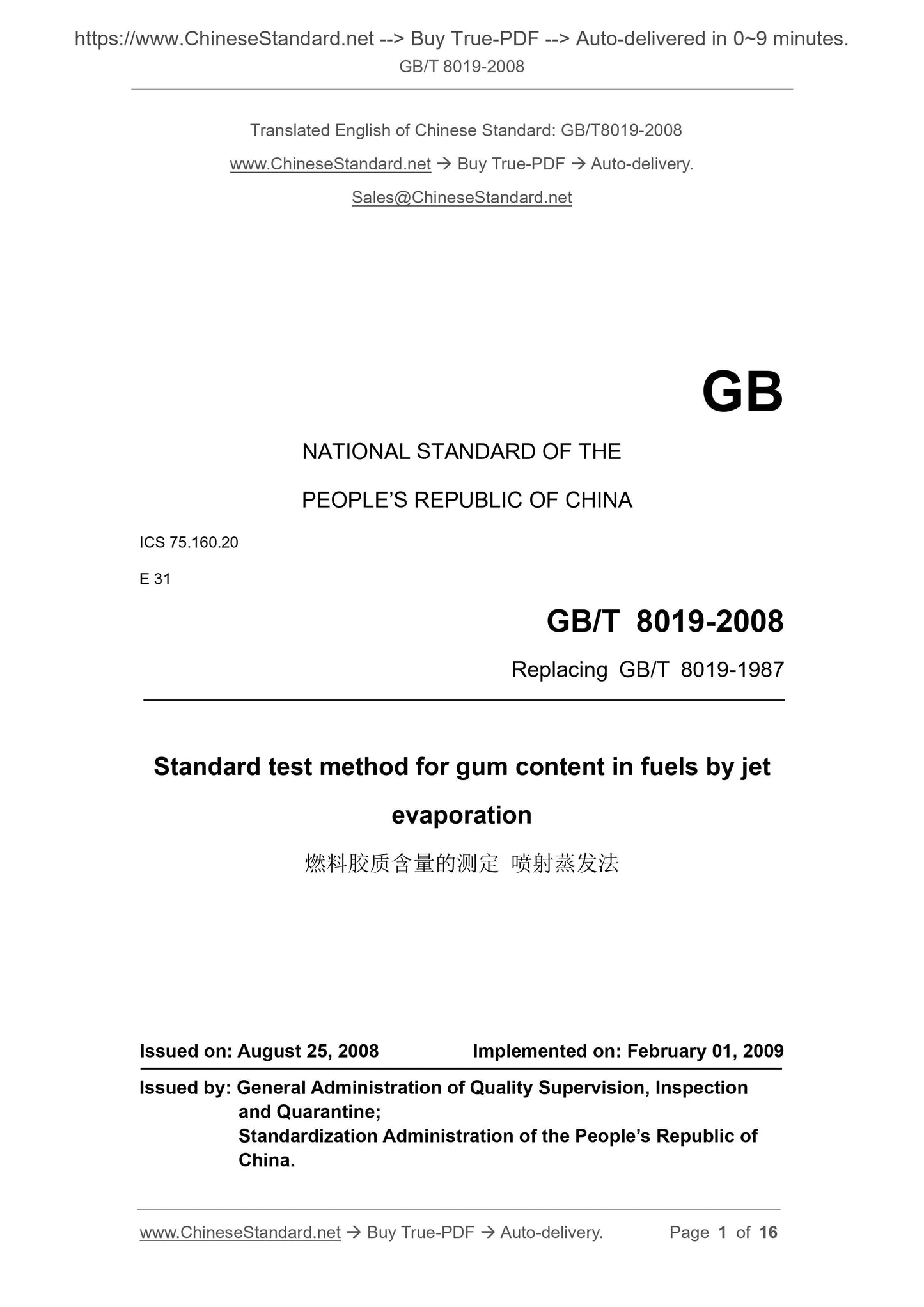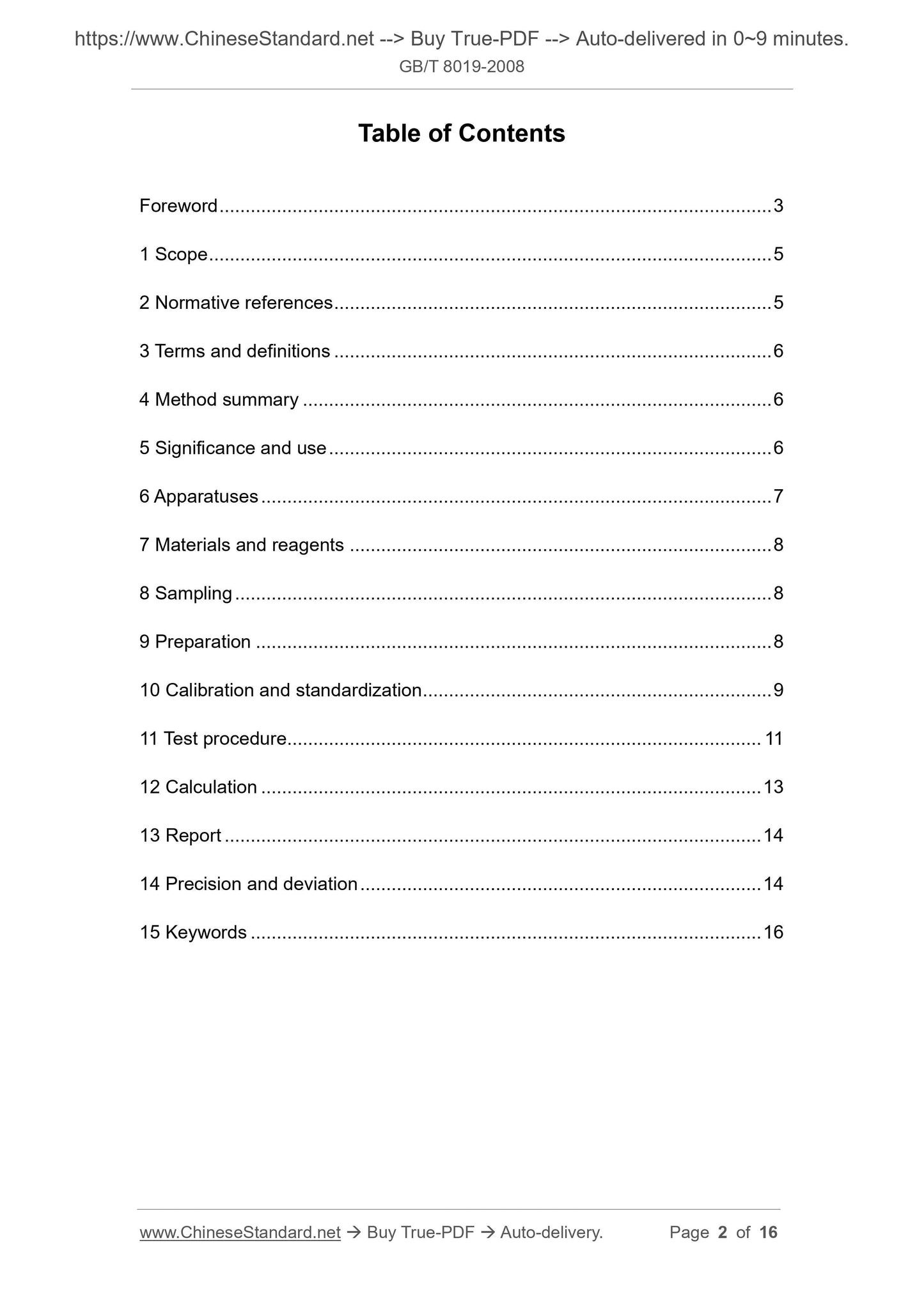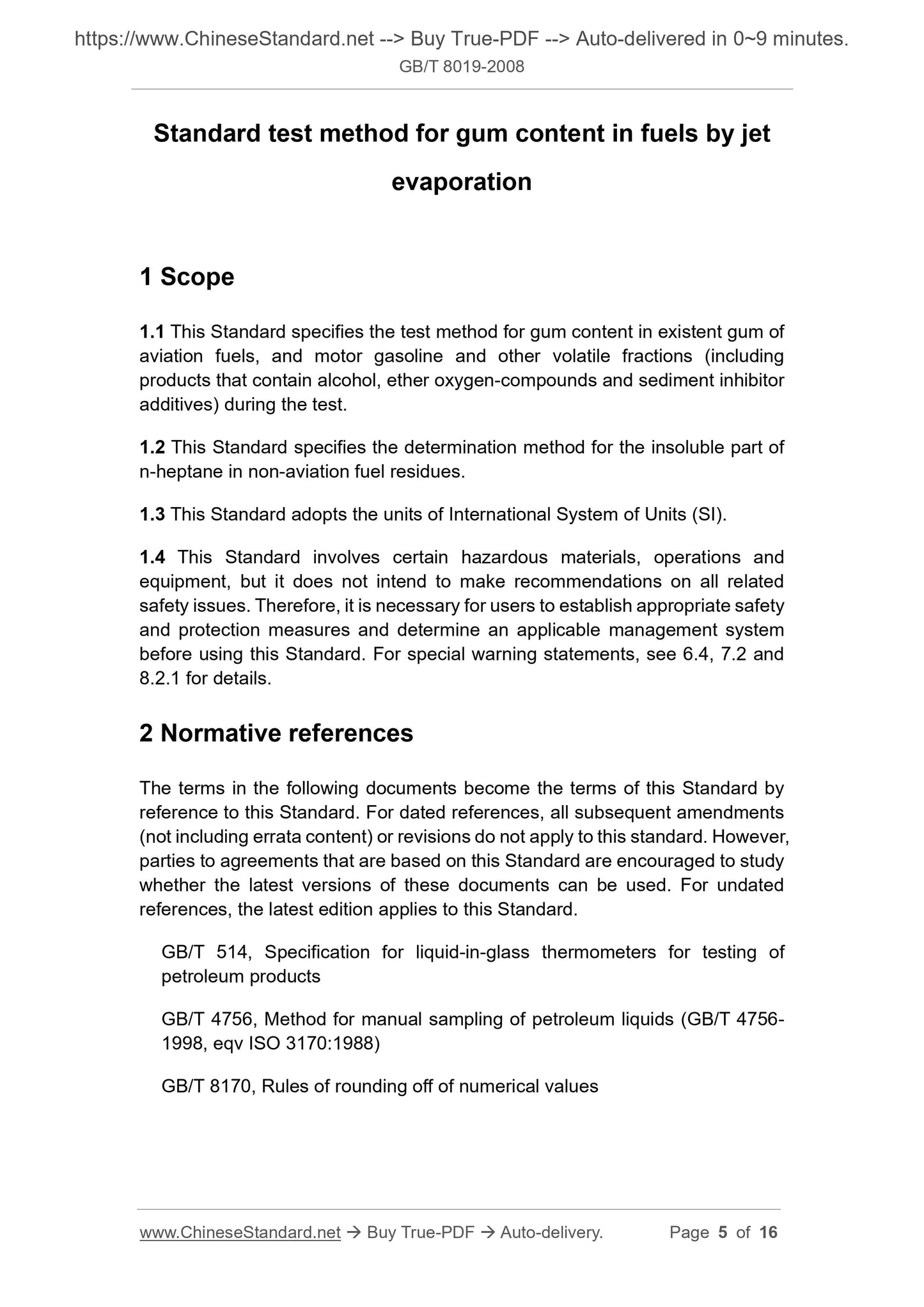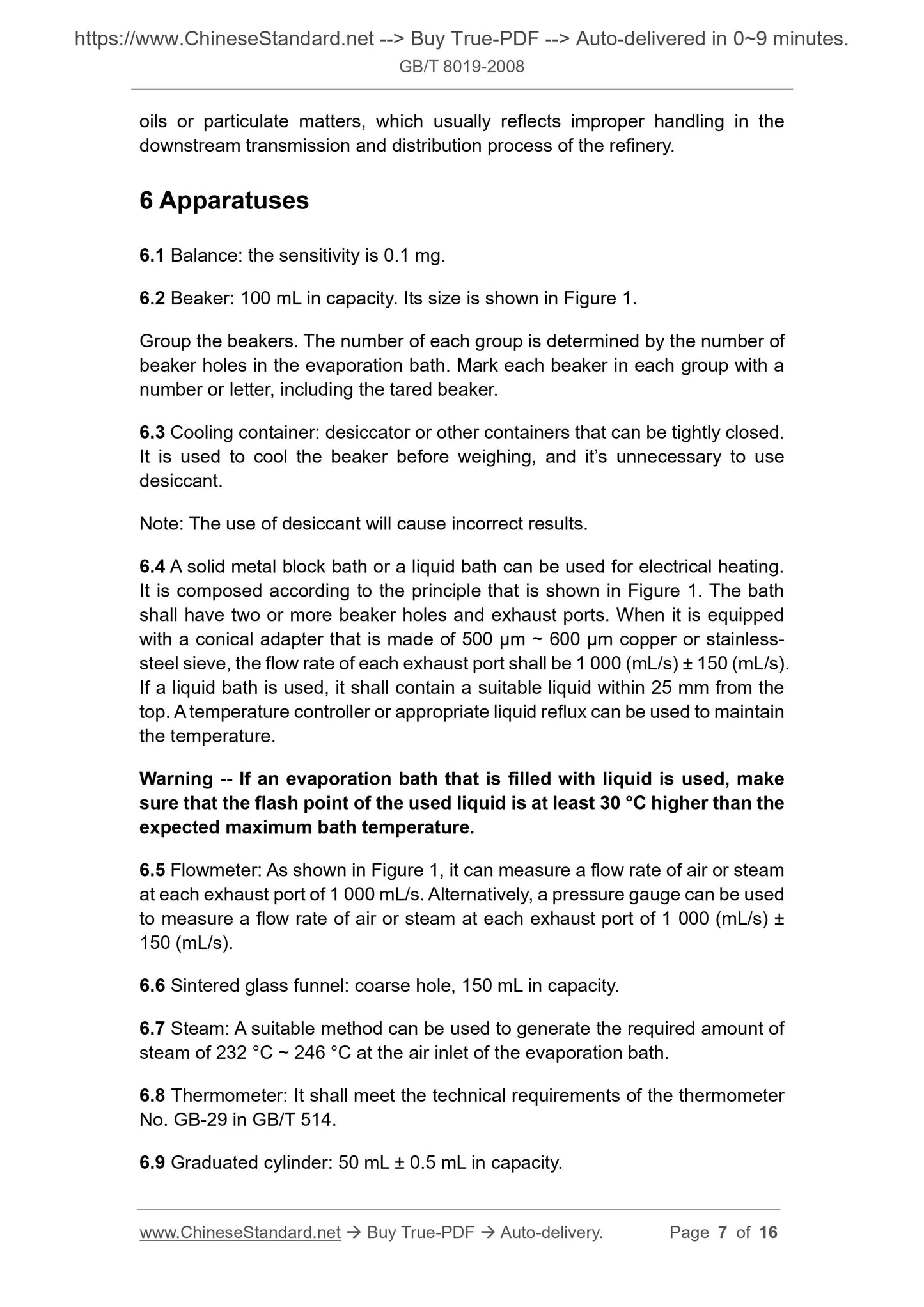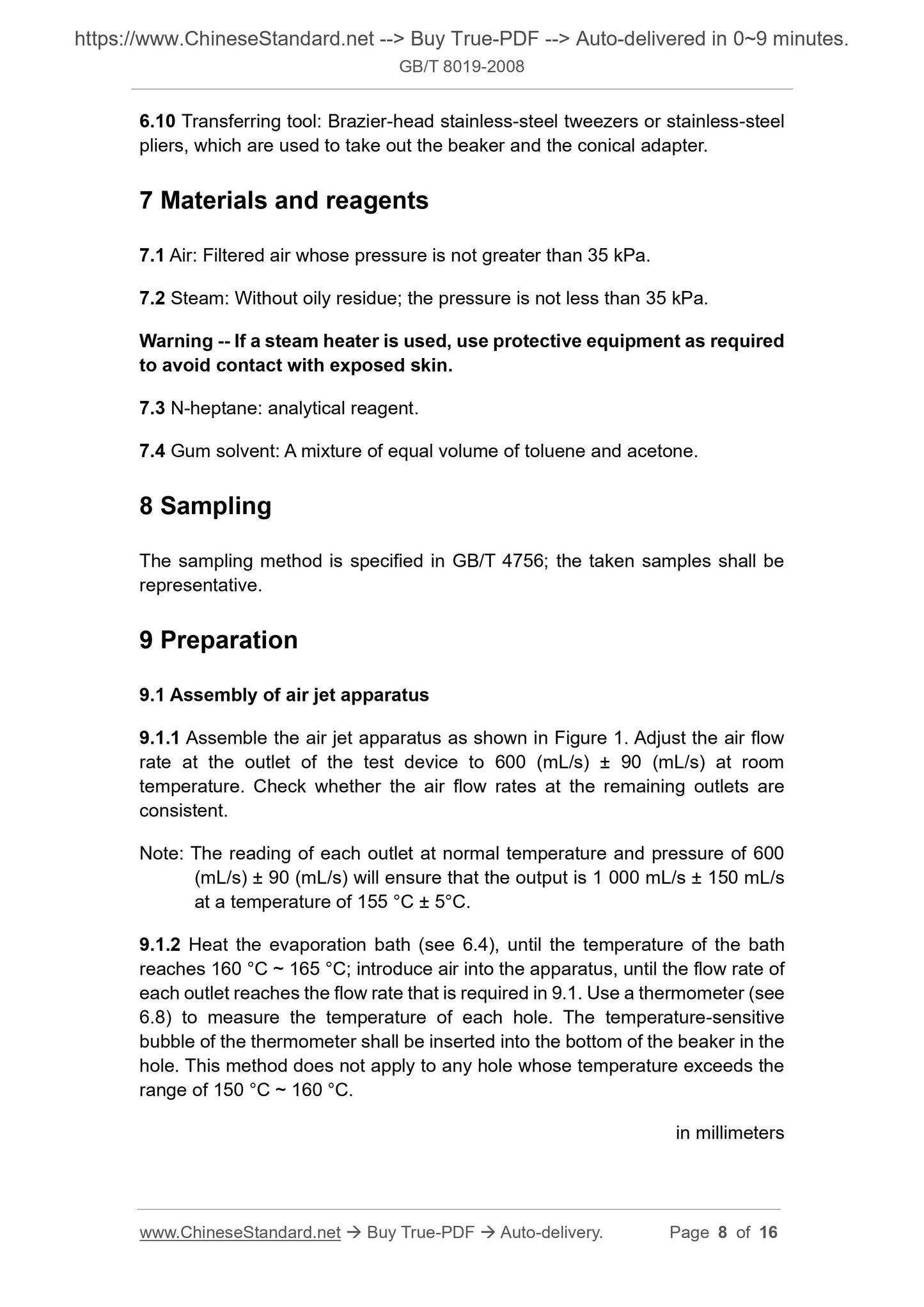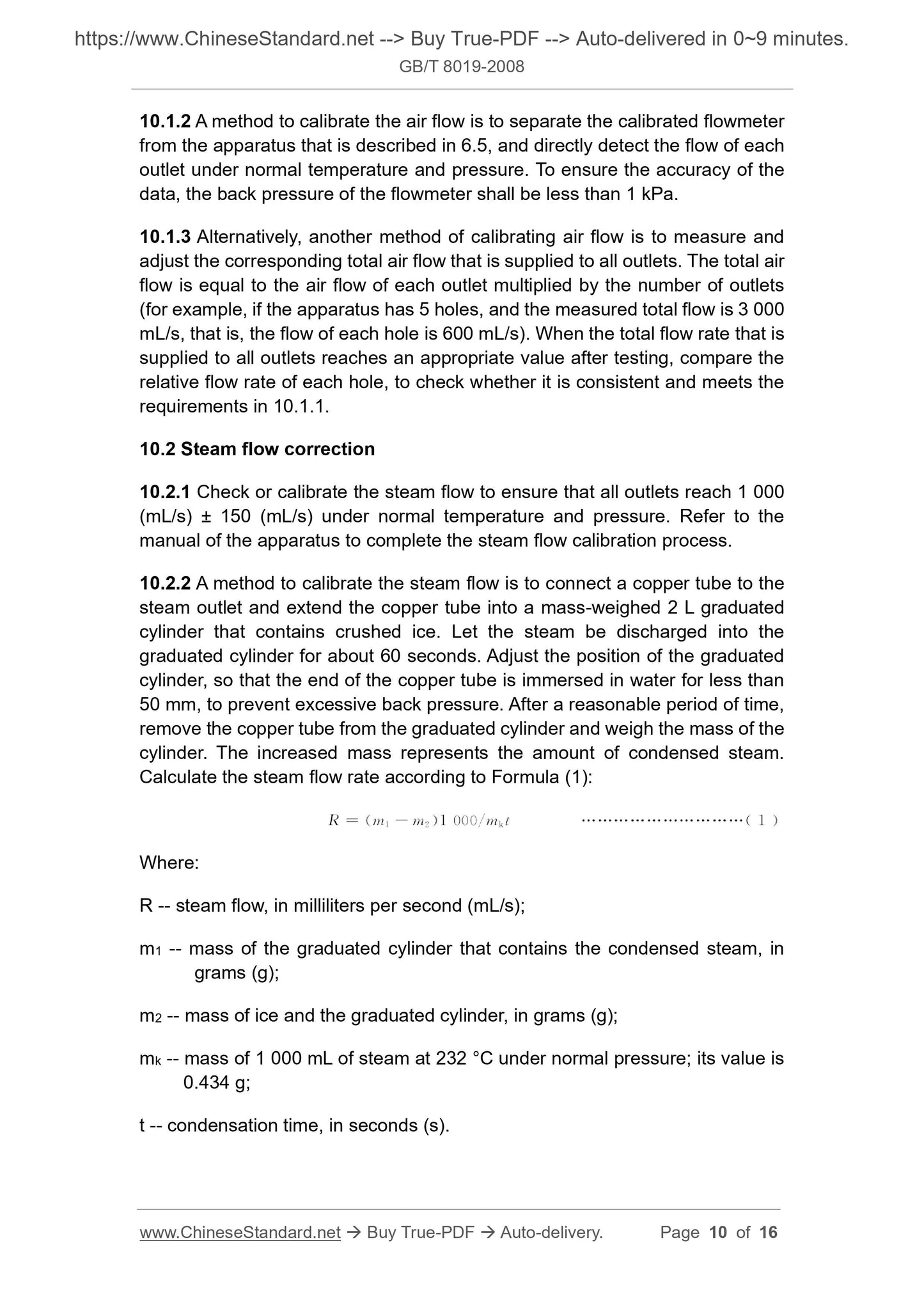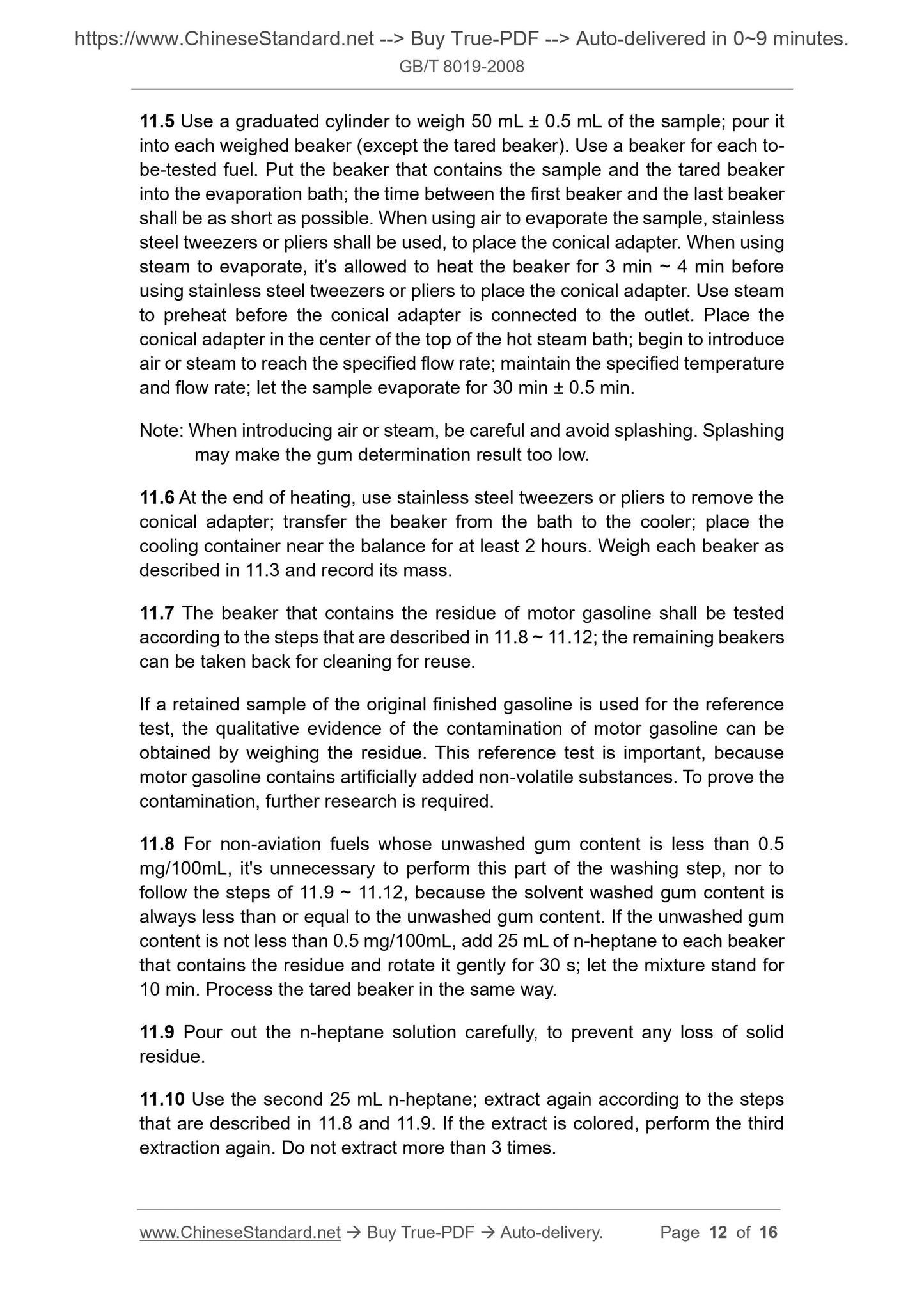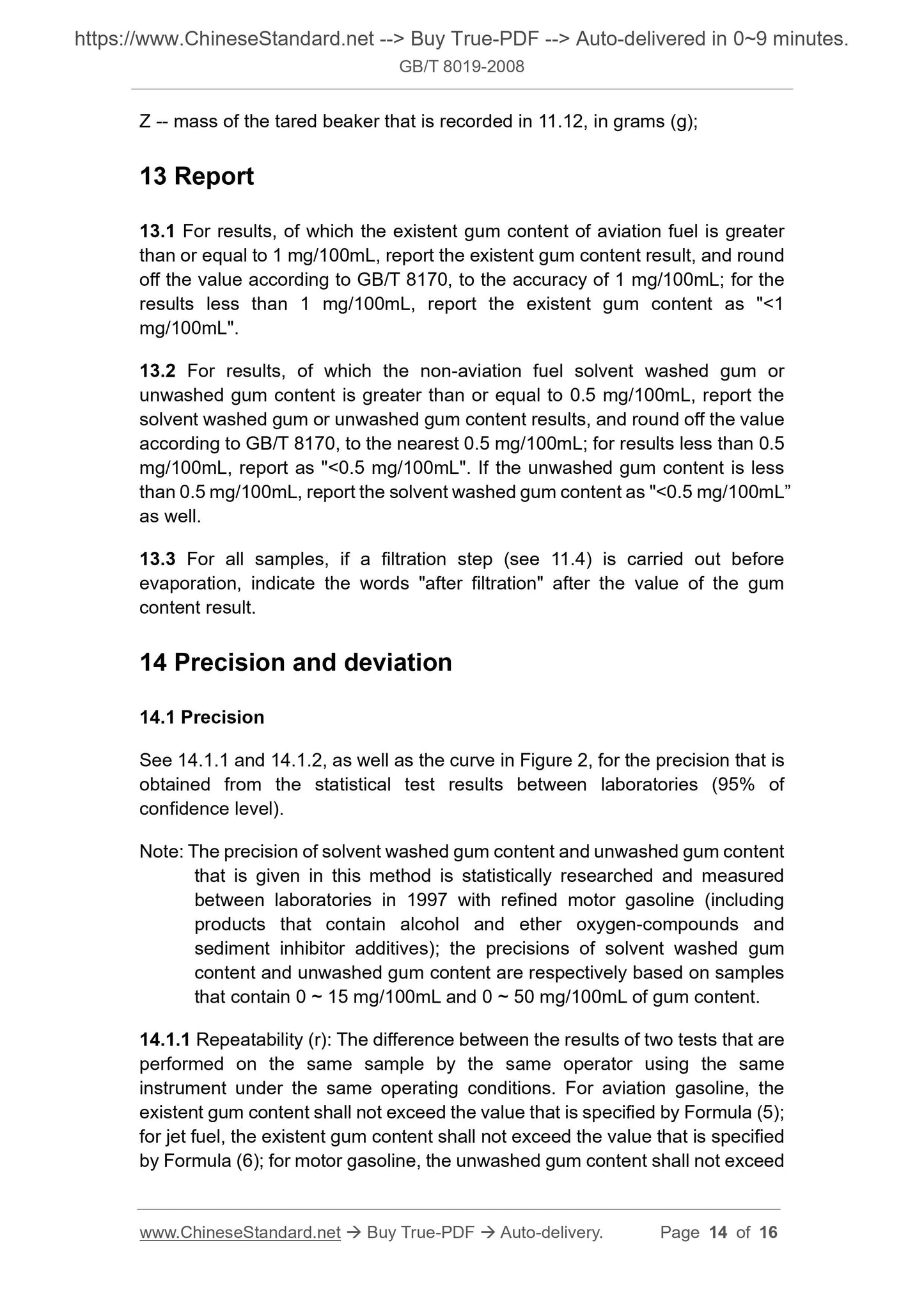1
/
of
8
PayPal, credit cards. Download editable-PDF and invoice in 1 second!
GB/T 8019-2008 English PDF (GBT8019-2008)
GB/T 8019-2008 English PDF (GBT8019-2008)
Regular price
$160.00 USD
Regular price
Sale price
$160.00 USD
Unit price
/
per
Shipping calculated at checkout.
Couldn't load pickup availability
Delivery: 3 seconds. Download true-PDF + Invoice.
Get QUOTATION in 1-minute: Click GB/T 8019-2008
Historical versions: GB/T 8019-2008
Preview True-PDF (Reload/Scroll if blank)
GB/T 8019-2008: Standard test method for gum content in fuels -- By jet evaporation
GB/T 8019-2008
GB
NATIONAL STANDARD OF THE
PEOPLE’S REPUBLIC OF CHINA
ICS 75.160.20
E 31
Replacing GB/T 8019-1987
Standard test method for gum content in fuels by jet
evaporation
ISSUED ON: AUGUST 25, 2008
IMPLEMENTED ON: FEBRUARY 01, 2009
Issued by: General Administration of Quality Supervision, Inspection
and Quarantine;
Standardization Administration of the People’s Republic of
China.
Table of Contents
Foreword ... 3
1 Scope ... 5
2 Normative references ... 5
3 Terms and definitions ... 6
4 Method summary ... 6
5 Significance and use ... 6
6 Apparatuses ... 7
7 Materials and reagents ... 8
8 Sampling ... 8
9 Preparation ... 8
10 Calibration and standardization ... 9
11 Test procedure... 11
12 Calculation ... 13
13 Report ... 14
14 Precision and deviation ... 14
15 Keywords ... 16
Standard test method for gum content in fuels by jet
evaporation
1 Scope
1.1 This Standard specifies the test method for gum content in existent gum of
aviation fuels, and motor gasoline and other volatile fractions (including
products that contain alcohol, ether oxygen-compounds and sediment inhibitor
additives) during the test.
1.2 This Standard specifies the determination method for the insoluble part of
n-heptane in non-aviation fuel residues.
1.3 This Standard adopts the units of International System of Units (SI).
1.4 This Standard involves certain hazardous materials, operations and
equipment, but it does not intend to make recommendations on all related
safety issues. Therefore, it is necessary for users to establish appropriate safety
and protection measures and determine an applicable management system
before using this Standard. For special warning statements, see 6.4, 7.2 and
8.2.1 for details.
2 Normative references
The terms in the following documents become the terms of this Standard by
reference to this Standard. For dated references, all subsequent amendments
(not including errata content) or revisions do not apply to this standard. However,
parties to agreements that are based on this Standard are encouraged to study
whether the latest versions of these documents can be used. For undated
references, the latest edition applies to this Standard.
GB/T 514, Specification for liquid-in-glass thermometers for testing of
petroleum products
GB/T 4756, Method for manual sampling of petroleum liquids (GB/T 4756-
1998, eqv ISO 3170:1988)
GB/T 8170, Rules of rounding off of numerical values
oils or particulate matters, which usually reflects improper handling in the
downstream transmission and distribution process of the refinery.
6 Apparatuses
6.1 Balance: the sensitivity is 0.1 mg.
6.2 Beaker: 100 mL in capacity. Its size is shown in Figure 1.
Group the beakers. The number of each group is determined by the number of
beaker holes in the evaporation bath. Mark each beaker in each group with a
number or letter, including the tared beaker.
6.3 Cooling container: desiccator or other containers that can be tightly closed.
It is used to cool the beaker before weighing, and it’s unnecessary to use
desiccant.
Note: The use of desiccant will cause incorrect results.
6.4 A solid metal block bath or a liquid bath can be used for electrical heating.
It is composed according to the principle that is shown in Figure 1. The bath
shall have two or more beaker holes and exhaust ports. When it is equipped
with a conical adapter that is made of 500 μm ~ 600 μm copper or stainless-
steel sieve, the flow rate of each exhaust port shall be 1 000 (mL/s) ± 150 (mL/s).
If a liquid bath is used, it shall contain a suitable liquid within 25 mm from the
top. A temperature controller or appropriate liquid reflux can be used to maintain
the temperature.
Warning -- If an evaporation bath that is filled with liquid is used, make
sure that the flash point of the used liquid is at least 30 °C higher than the
expected maximum bath temperature.
6.5 Flowmeter: As shown in Figure 1, it can measure a flow rate of air or steam
at each exhaust port of 1 000 mL/s. Alternatively, a pressure gauge can be used
to measure a flow rate of air or steam at each exhaust port of 1 000 (mL/s) ±
150 (mL/s).
6.6 Sintered glass funnel: coarse hole, 150 mL in capacity.
6.7 Steam: A suitable method can be used to generate the required amount of
steam of 232 °C ~ 246 °C at the air inlet of the evaporation bath.
6.8 Thermometer: It shall meet the technical requirements of the thermometer
No. GB-29 in GB/T 514.
6.9 Graduated cylinder: 50 mL ± 0.5 mL in capacity.
6.10 Transferring tool: Brazier-head stainless-steel tweezers or stainless-steel
pliers, which are used to take out the beaker and the conical adapter.
7 Materials and reagents
7.1 Air: Filtered air whose pressure is not greater than 35 kPa.
7.2 Steam: Without oily residue; the pressure is not less than 35 kPa.
Warning -- If a steam heater is used, use protective equipment as required
to avoid contact with exposed skin.
7.3 N-heptane: analytical reagent.
7.4 Gum solvent: A mixture of equal volume of toluene and acetone.
8 Sampling
The sampling method is specified in GB/T 4756; the taken samples shall be
representative.
9 Preparation
9.1 Assembly of air jet apparatus
9.1.1 Assemble the air jet apparatus as shown in Figure 1. Adjust the air flow
rate at the outlet of the test device to 600 (mL/s) ± 90 (mL/s) at room
temperature. Check whether the air flow rates at the remaining outlets are
consistent.
Note: The reading of each outlet at normal temperature and pressure of 600
(mL/s) ± 90 (mL/s) will ensure that the output is 1 000 mL/s ± 150 mL/s
at a temperature of 155 °C ± 5°C.
9.1.2 Heat the evaporation bath (see 6.4), until the temperature of the bath
reaches 160 °C ~ 165 °C; introduce air into the apparatus, until the flow rate of
each outlet reaches the flow rate that is required in 9.1. Use a thermometer (see
6.8) to measure the temperature of each hole. The temperature-sensitive
bubble of the thermometer shall be inserted into the bottom of the beaker in the
hole. This method does not apply to any hole whose temperature exceeds the
range of 150 °C ~ 160 °C.
in millimeters
10.1.2 A method to calibrate the air flow is to separate the calibrated flowmeter
from the apparatus that is described in 6.5, and directly detect the flow of each
outlet under normal temperature and pressure. To ensure the accuracy of the
data, the back pressure of the flowmeter shall be less than 1 kPa.
10.1.3 Alternatively, another method of calibrating air flow is to measure and
adjust the corresponding total air flow that is supplied to all outlets. The total air
flow is equal to the air flow of each outlet multiplied by the number of outlets
(for example, if the apparatus has 5 holes, and the measured total flow is 3 000
mL/s, that is, the flow of each hole is 600 mL/s). When the total flow rate that is
supplied to all outlets reaches an appropriate value after testing, compare the
relative flow rate of each hole, to check whether it is consistent and meets the
requirements in 10.1.1.
10.2 Steam flow correction
10.2.1 Check or calibrate the steam flow to ensure that all outlets reach 1 000
(mL/s) ± 150 (mL/s) under normal temperature and pressure. Refer to the
manual of the apparatus to complete the steam flow calibration process.
10.2.2 A method to calibrate the steam flow is to connect a copper tube to the ...
Get QUOTATION in 1-minute: Click GB/T 8019-2008
Historical versions: GB/T 8019-2008
Preview True-PDF (Reload/Scroll if blank)
GB/T 8019-2008: Standard test method for gum content in fuels -- By jet evaporation
GB/T 8019-2008
GB
NATIONAL STANDARD OF THE
PEOPLE’S REPUBLIC OF CHINA
ICS 75.160.20
E 31
Replacing GB/T 8019-1987
Standard test method for gum content in fuels by jet
evaporation
ISSUED ON: AUGUST 25, 2008
IMPLEMENTED ON: FEBRUARY 01, 2009
Issued by: General Administration of Quality Supervision, Inspection
and Quarantine;
Standardization Administration of the People’s Republic of
China.
Table of Contents
Foreword ... 3
1 Scope ... 5
2 Normative references ... 5
3 Terms and definitions ... 6
4 Method summary ... 6
5 Significance and use ... 6
6 Apparatuses ... 7
7 Materials and reagents ... 8
8 Sampling ... 8
9 Preparation ... 8
10 Calibration and standardization ... 9
11 Test procedure... 11
12 Calculation ... 13
13 Report ... 14
14 Precision and deviation ... 14
15 Keywords ... 16
Standard test method for gum content in fuels by jet
evaporation
1 Scope
1.1 This Standard specifies the test method for gum content in existent gum of
aviation fuels, and motor gasoline and other volatile fractions (including
products that contain alcohol, ether oxygen-compounds and sediment inhibitor
additives) during the test.
1.2 This Standard specifies the determination method for the insoluble part of
n-heptane in non-aviation fuel residues.
1.3 This Standard adopts the units of International System of Units (SI).
1.4 This Standard involves certain hazardous materials, operations and
equipment, but it does not intend to make recommendations on all related
safety issues. Therefore, it is necessary for users to establish appropriate safety
and protection measures and determine an applicable management system
before using this Standard. For special warning statements, see 6.4, 7.2 and
8.2.1 for details.
2 Normative references
The terms in the following documents become the terms of this Standard by
reference to this Standard. For dated references, all subsequent amendments
(not including errata content) or revisions do not apply to this standard. However,
parties to agreements that are based on this Standard are encouraged to study
whether the latest versions of these documents can be used. For undated
references, the latest edition applies to this Standard.
GB/T 514, Specification for liquid-in-glass thermometers for testing of
petroleum products
GB/T 4756, Method for manual sampling of petroleum liquids (GB/T 4756-
1998, eqv ISO 3170:1988)
GB/T 8170, Rules of rounding off of numerical values
oils or particulate matters, which usually reflects improper handling in the
downstream transmission and distribution process of the refinery.
6 Apparatuses
6.1 Balance: the sensitivity is 0.1 mg.
6.2 Beaker: 100 mL in capacity. Its size is shown in Figure 1.
Group the beakers. The number of each group is determined by the number of
beaker holes in the evaporation bath. Mark each beaker in each group with a
number or letter, including the tared beaker.
6.3 Cooling container: desiccator or other containers that can be tightly closed.
It is used to cool the beaker before weighing, and it’s unnecessary to use
desiccant.
Note: The use of desiccant will cause incorrect results.
6.4 A solid metal block bath or a liquid bath can be used for electrical heating.
It is composed according to the principle that is shown in Figure 1. The bath
shall have two or more beaker holes and exhaust ports. When it is equipped
with a conical adapter that is made of 500 μm ~ 600 μm copper or stainless-
steel sieve, the flow rate of each exhaust port shall be 1 000 (mL/s) ± 150 (mL/s).
If a liquid bath is used, it shall contain a suitable liquid within 25 mm from the
top. A temperature controller or appropriate liquid reflux can be used to maintain
the temperature.
Warning -- If an evaporation bath that is filled with liquid is used, make
sure that the flash point of the used liquid is at least 30 °C higher than the
expected maximum bath temperature.
6.5 Flowmeter: As shown in Figure 1, it can measure a flow rate of air or steam
at each exhaust port of 1 000 mL/s. Alternatively, a pressure gauge can be used
to measure a flow rate of air or steam at each exhaust port of 1 000 (mL/s) ±
150 (mL/s).
6.6 Sintered glass funnel: coarse hole, 150 mL in capacity.
6.7 Steam: A suitable method can be used to generate the required amount of
steam of 232 °C ~ 246 °C at the air inlet of the evaporation bath.
6.8 Thermometer: It shall meet the technical requirements of the thermometer
No. GB-29 in GB/T 514.
6.9 Graduated cylinder: 50 mL ± 0.5 mL in capacity.
6.10 Transferring tool: Brazier-head stainless-steel tweezers or stainless-steel
pliers, which are used to take out the beaker and the conical adapter.
7 Materials and reagents
7.1 Air: Filtered air whose pressure is not greater than 35 kPa.
7.2 Steam: Without oily residue; the pressure is not less than 35 kPa.
Warning -- If a steam heater is used, use protective equipment as required
to avoid contact with exposed skin.
7.3 N-heptane: analytical reagent.
7.4 Gum solvent: A mixture of equal volume of toluene and acetone.
8 Sampling
The sampling method is specified in GB/T 4756; the taken samples shall be
representative.
9 Preparation
9.1 Assembly of air jet apparatus
9.1.1 Assemble the air jet apparatus as shown in Figure 1. Adjust the air flow
rate at the outlet of the test device to 600 (mL/s) ± 90 (mL/s) at room
temperature. Check whether the air flow rates at the remaining outlets are
consistent.
Note: The reading of each outlet at normal temperature and pressure of 600
(mL/s) ± 90 (mL/s) will ensure that the output is 1 000 mL/s ± 150 mL/s
at a temperature of 155 °C ± 5°C.
9.1.2 Heat the evaporation bath (see 6.4), until the temperature of the bath
reaches 160 °C ~ 165 °C; introduce air into the apparatus, until the flow rate of
each outlet reaches the flow rate that is required in 9.1. Use a thermometer (see
6.8) to measure the temperature of each hole. The temperature-sensitive
bubble of the thermometer shall be inserted into the bottom of the beaker in the
hole. This method does not apply to any hole whose temperature exceeds the
range of 150 °C ~ 160 °C.
in millimeters
10.1.2 A method to calibrate the air flow is to separate the calibrated flowmeter
from the apparatus that is described in 6.5, and directly detect the flow of each
outlet under normal temperature and pressure. To ensure the accuracy of the
data, the back pressure of the flowmeter shall be less than 1 kPa.
10.1.3 Alternatively, another method of calibrating air flow is to measure and
adjust the corresponding total air flow that is supplied to all outlets. The total air
flow is equal to the air flow of each outlet multiplied by the number of outlets
(for example, if the apparatus has 5 holes, and the measured total flow is 3 000
mL/s, that is, the flow of each hole is 600 mL/s). When the total flow rate that is
supplied to all outlets reaches an appropriate value after testing, compare the
relative flow rate of each hole, to check whether it is consistent and meets the
requirements in 10.1.1.
10.2 Steam flow correction
10.2.1 Check or calibrate the steam flow to ensure that all outlets reach 1 000
(mL/s) ± 150 (mL/s) under normal temperature and pressure. Refer to the
manual of the apparatus to complete the steam flow calibration process.
10.2.2 A method to calibrate the steam flow is to connect a copper tube to the ...
Share
